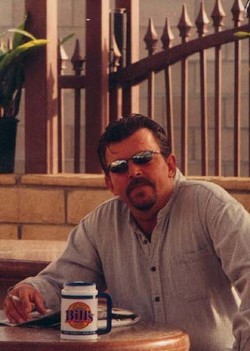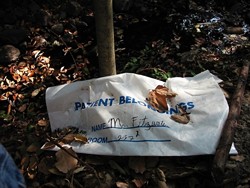San Luis Obispo's dying fields
In recent months, three seriously ill men have walked to the field across the street from a local shelter to die
By Karen Velie[{
"name": "Ad - Medium Rectangle CC01 - 300x250",
"id": "AdMediumRectangleCC01300x250",
"class": "inlineCenter",
"insertPoint": "8",
"component": "2963441",
"requiredCountToDisplay": "12"
},{
"name": "Ad - Medium Rectangle LC01 - 300x250",
"id": "AdMediumRectangleCC01300x250",
"class": "inlineCenter",
"insertPoint": "18",
"component": "2963441",
"requiredCountToDisplay": "22"
},{
"name": "Ad - Medium Rectangle LC09 - 300x250",
"id": "AdMediumRectangleLC09300x250",
"class": "inlineCenter",
"insertPoint": "28",
"component": "3252660",
"requiredCountToDisplay": "32"
}]
On the south side of San Luis Obispo, amid blackberry bushes and eucalyptus trees, is a field where three local homeless men perished in less than five months.
# There were no stab wounds. There were no bullet holes. In fact, there were no signs of a struggle. However, shortly before their deaths, all three men had been discharged from local hospitals.
From the shopping center and residential neighborhood that border the field alongside Orcutt Road, between Broad Street and a little southwest of Laurel Lane, you can't see the makeshift tents and lean-tos hidden among the trees and bushes. You wouldn't know that numerous less-fortunate residents of the community sleep next to a small creek that meanders through the field littered with sleeping bags, blankets, and patient-discharge bags.
David Fitzwater, 49, was a shell of a man, more than 6 feet tall and a slight 160 pounds. Afflicted with crippling arthritis, a heart condition, and bleeding ulcers, he lived in agony. In spite of his angst, however, he volunteered his time gardening at the Prado Day Center and performing chores at the San Luis Obispo homeless shelter. People loved him.
Shortly before sunset on Oct. 4, Fitzwater's bloated and discolored body was discovered by two homeless men in the dirt field across the street from San Luis Obispo's homeless shelter on Orcutt Road. A plastic hospital discharge bag, bearing his name, still lies atop a pile of fallen leaves near where Fitzwater's body was found.
"His pants were down around his ankles, and his legs looked like he was wearing tie-dye leotards," said John, a homeless man who resides in the field. "I tried to wake him up, and then I called 911."
On June 26, just a few months earlier, David Downing, 46, also perished across from the shelter. Shortly after that, on Independence Day, John Gabriel met his demise in the same field.
Approximately a week before his untimely death, Gabriel, 47, was
# assaulted by two men while walking along the 2600 block of McMillan Avenue, according to a Tribune article. He suffered fractured ribs and numerous cuts and bruises, police said. He was taken to French Hospital Medical Center and released without transportation, battered and weak, at 2 a.m., Gabriel's friend said."Our records show he was not discharged to the street and he was assaulted a couple weeks before he died," said Megan Maloney, communication manager at French Hospital.
Whatever the case of these men, stories abound of how homeless patients are sometimes sent back to the streets after being discharged from various hospitals, sporting hospital gowns or urine-soaked rags, penniless, and too weak to fend for themselves. Some survive. Others do not.
"It's not foul play in the traditional sense, but it is foul play," said Interim Shelter Director Jody Smith.
Earlier this month, the Los Angeles Police Department announced that it had opened its first criminal investigation into the alleged dumping of homeless patients by two Los Angeles hospitals. For more than a year, investigators probed into whether or not the hospitals violated any laws in a practice that's become a major problem for officials and residents of the city.
Even so, the Los Angeles District Attorney's office is unclear if the hospitals violated any laws by dumping patients on skid row. The hospitals have denied any wrongdoing.
Human catastrophe
A few months ago, a 42-year-old lifelong resident of the county was transported clad in his hospital gown and sporting a plastic medical bracelet from a local hospital and dropped at the homeless shelter in Atascadero, said Ronnie Nevarez, interim North County program manager for EOC's homeless services.
The man a Paso Robles High School graduate and an amputee from the knee down as a result of severe diabetes couldn't manage the shelter stairs.
# "He was weak from being hospitalized," Nevarez said. "We tried to get him to a hotel room. He never made it."
While frustrated shelter workers attempted to arrange for transportation to the hotel, the shaky amputee fell, hit his head, and was transported by ambulance back to the hospital. He died a few days later.
"We have so many people that are in need of transitional care it's heartbreaking that they have nowhere to go," Nevarez added. "It's hard on the hospitals, too. Their hands are tied. If patients are not ill enough to be in the hospital, they are sent home to recuperate. But homeless can't do that, and Medi-Cal won't pay for them to stay in the hospital. It's tough on the hospital social workers."
Though Rod Younhquist, Sierra Vista Hospital medical social worker, said he strives to set up after-care for homeless patients prior to their discharge, shelter workers claim that patients are dropped off at local shelters without notice or discharged at night without transportation.
"We need a follow-up respite center," Younhquist said. "A few days ago, I was able to find housing for a homeless patient, but it was unusual. We try to get people clothes before we release them. There are common guidelines for people who can stay in the hospital. Some fall through the cracks."
If Younhquist personally discharges a patient to a shelter, he always calls ahead, said Ron Yukelson, Sierra Vista Hospital spokesman.
"The guidelines for discharge of patients are on a case-by-case basis," Yukelson explained. "As you can imagine, no two patients are the same. The hospital does not discharge patients doctors discharge patents. We are not allowed to discharge patients until we get a doctor's order indicating the patient is able to be discharged from a medical and clinical standpoint."
Hospital social workers are entrusted with assisting homeless patients, who are either transferred by taxis to local shelters or discharged without transportation and left to fend for themselves.
Bobby Burkes, 72, underwent surgery for a perforated bowel on around July 6. The homeless senior citizen said he was released from French Hospital 13 days later.
"They kicked me out," Burkes said. "I was in bad shape. I could hardly walk. They cut me loose at 6 in the evening. I had nowhere to go. A nun from Arroyo Grande found me outside the hospital and got me a room for the night."
"We have no record of Bobby at this hospital," said French Hospital's Maloney. "Our social worker is on call. We don't discharge anyone without a discharge plan."
To that end, caseworkers and clients alike offered numerous examples of hospitals providing homeless patients with clean clothes, pharmaceuticals, and a few days of rest at local hotels.
# As an example, Bill, a homeless senior citizen, underwent a procedure in which doctors cut into his groin and sent a tube to his heart to search for blockages. Following his discharge, French Hospital provided him with three nights at a local hotel.
Even so, local shelter workers described story after sad story. When a double amputee was released from French Hospital, one story goes, he wheeled himself for miles, all the way to the shelter. Another tale tells of a taxi that dropped a homeless man covered in feces and urine and sporting a colostomy bag at the San Luis Obispo shelter.
"We can't always make all the social decisions that need to be made," said Drew Washer, French Hospital's clinical social worker. "I am the only social worker at the hospital. I am usually here from 8 [a.m.] to 5 [p.m.].
"I often drive to a pharmacy to fill their prescriptions," Washer added. "When their clothes are soiled, we often get them clothes. I call around looking for someplace for them to recuperate. I call because I want patients to get good care."
Despite the efforts of social workers, discharged patients from local hospitals sometimes arrive at county shelters weak, filthy, or clad in hospital gowns, according to shelter staff. Contagious or non-self-sufficient discharged patients are provided a blanket, but, due to restrictions, not a bed at the shelter.
Costs and effect
"It's a drain on the system when the homeless are rotated in and out of the hospital without stabilization," said Pam Hughes, Economic Opportunity Commission case manager. "It's not cost effective to have people cycle through without a way to get better."
Though there are between 2,500 and 4,000 homeless residents in San Luis Obispo County, the majority are in and out of homelessness fairly quickly. The chronically homeless cost the system the most in terms of medical bills and social services. They're often seen toting backpacks or sitting on benches throughout the county. Many are physically disabled, mentally ill, mentally challenged, elderly, or deep in the throes of alcoholism.
The chronically homeless cost taxpayers an average of $65,000 a year in medical costs alone, according to a UC San Diego Medical Center study.
"If they're out in a field cold and alone they're not going to get better. They're going to get worse," Hughes said. "We need a county rehab convalescent hospital and a detox center for indigent people."
Homeless alcoholics, required to pass a breathalyzer test before admission to the shelter, quit drinking approximately five hours before they attempt the test, said one shelter worker. They often suffer withdrawal seizures at the center and are carted by ambulance to hospital emergency rooms.
Living on the streets, constantly intoxicated, can be a dangerous dead-end but not as lethal as attempting to detox without medical supervision. Caseworkers warn homeless inebriants from attempting sobriety on their own.
There are 49 beds at the San Luis Obispo homeless shelter and another 30 in Atascadero. In order to partake of the shelter's services, clients are required to be self-sufficient.
"If they are very ill, we can't help them. We can't address medical issues, and we can't expose the children and families to contagious clients," Hughes said.
Those lucky enough to find a bed for the night are required to leave the shelter at 7 a.m. each morning. They must walk up a hill to the nearest bus stop where they can catch a bus to the Prado Day Center or wander the streets. From 5:30 p.m. till 7 p.m., they can return to the shelter if a bed is available.
"Our shelters are so full, we have to turn people away who have no place to go," Nevarez said. "Families are our priority. We have 30 beds, but only five are for singles. We really need another emergency shelter and an overflow shelter."
Homeless advocates, case managers, and social workers are working together to find an answer, and agree that there's an urgent need in the county for a detox center and a convalescent care facility for indigent people.
In Denver, local agencies have introduced a new program aimed at providing assistance to the chronically homeless while saving taxpayers thousands of dollars. Clients are provided efficiency lodging a place to spend afternoons away from local downtown businesses at approximately $15,000 a year per enrollee, less than a third of what it costs to leave them in a field.
"We have the ability in our county to provide services," Shelter Director Smith said. "We need to work together, in a collaborative effort, to provide services."
Downing's last days
Downing who died of cancer on June 26, in the field across from the shelter was an ex-Marine who suffered from post-traumatic stress syndrome. His chosen drink was vodka. His friends called him Vodka Dave.
"He had asked repeatedly if we could get him into detox, but I couldn't find one," said Hughes, Downing's caseworker.
# Downing wanted to quit drinking, but his caseworkers warned him against going through dangerous withdrawals without medical supervision. Early last June, doctors gave Downing three months to live. He died three weeks later.
"Homelessness is hazardous to your health," Hughes emphasized. "It's a cold, cruel world out there."
Downing's friends homeless men living in the field across from the shelter went down to the Goodwill, purchased a mattress, and dragged it down the railroad tracks.
They adjusted his makeshift bed so he could gaze upon the field's wildflowers while he died. He loved nature, they said.
"If he was a dog or a seal, he wouldn't have died alone in a field." Hughes said, her voice cracking. "We don't have the outpouring for these people because they're not warm and fuzzy. It's like having a Third World country in our own community that no one wants to look at." ?
Staff Writer Karen Velie can be reached at [email protected].
INFO BOX #1: Last words
Near the end of his short life, David Downing wrote out a poem on a crumpled piece of lined white paper:
I hopped offa freight train
and what did I see
I saw a band of American refugees.
As I rolled out my bedroll
I looked over to see
an old gray haired man
gazing at me.
His clothes dirty, torn, and well used
its hard to believe the things
on his feet were called shoes.
As I looked into his eyes
and seen the sorrow and pain
he pulled out his jug
and took a drink just the same.
Years went by me not thinking
of these things until the lord
restored bits of my memory
to me.
You see I was kickin it at
a train yard thinking I was
free when I looked over to
see a younger man gazing
at me his eyes were full
of life and hope and no shame.
But I pulled out my jug and
took a drink just the same.
INFO BOX #2: Local homeless statistics
The San Luis Obispo County Board of Supervisors, together with Cal Poly, last year funded a study conducted by the Homeless Services Coordinating Council. On Oct 26, 2005, they performed a one-day count of homeless people in the county. Though there's some controversy in regard to the total number of homeless living in the county, no one disputes that 2,408 people were counted as homeless that day. Other study results show that:
the face of homelessness has changed from adult to child and from male to female.
children and teens make up 34 percent of county homeless.
approximately 20 percent of area homeless are transients.
approximately 40 percent of area homeless sleep outdoors.
South County accounted for the largest concentration of homeless: 43 percent. North County accounted for 30 percent. San Luis Obispo City accounted for 24 percent.
Latest in News
Readers also liked…
-

Coast Unified teachers upset over new position's salary and qualifications
Oct 20, 2022 -

SLO police identify alleged driver who hit and killed couple
Dec 22, 2022 -

When the levee breaks: Oceano residents, county officials walk a tightrope of regulations to manage Arroyo Grande Creek, which some say led to the levee's failure in January
May 18, 2023











